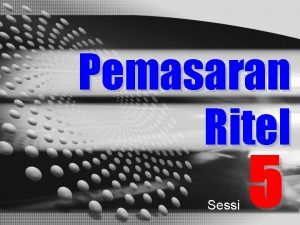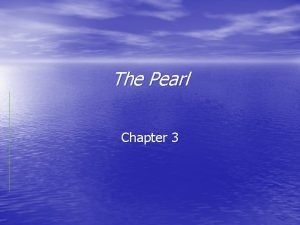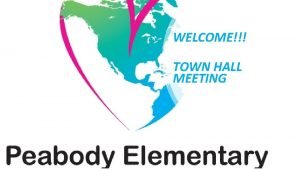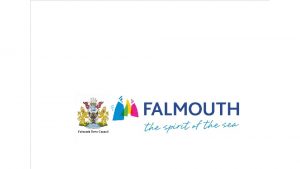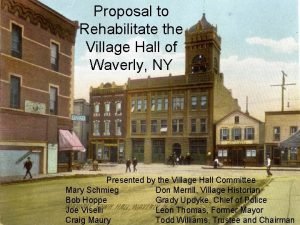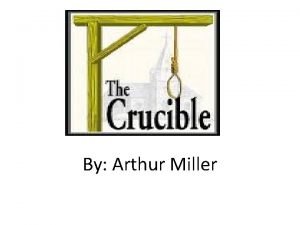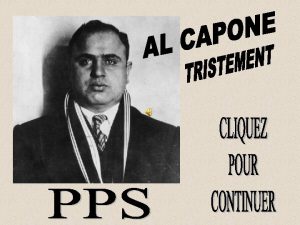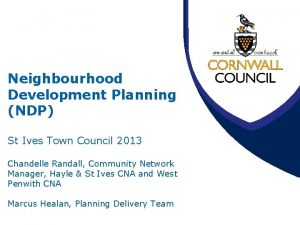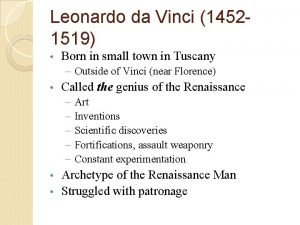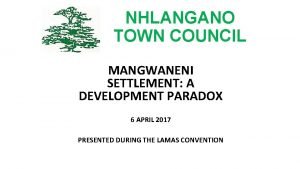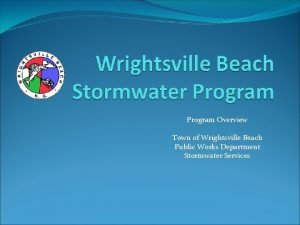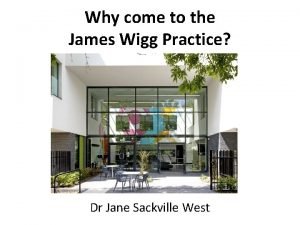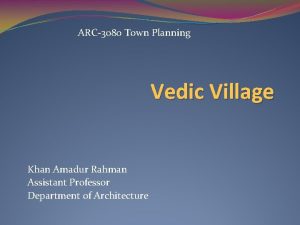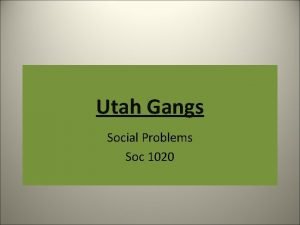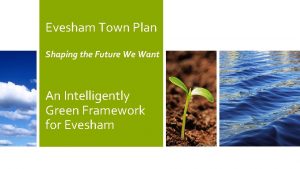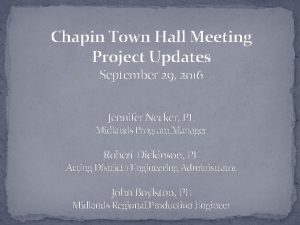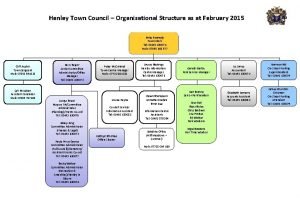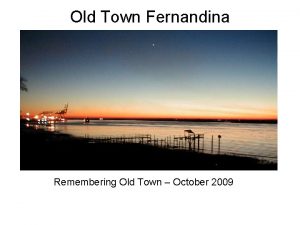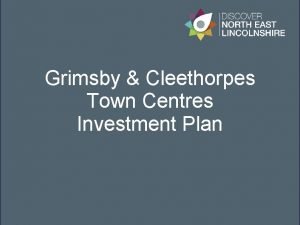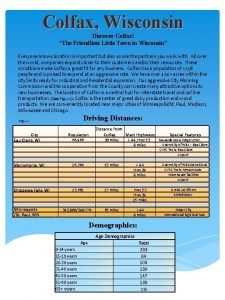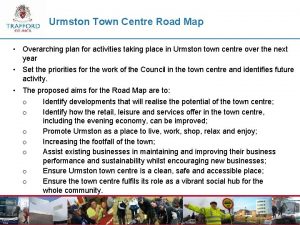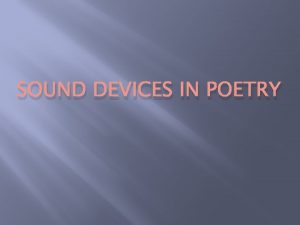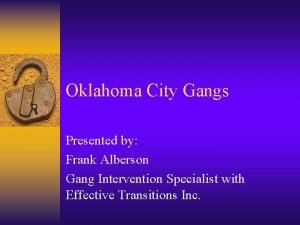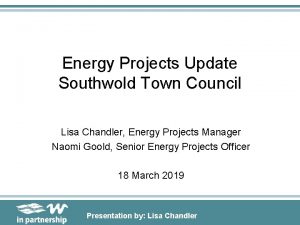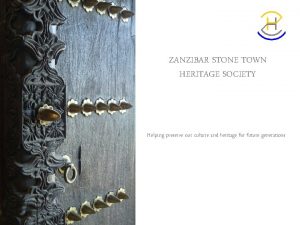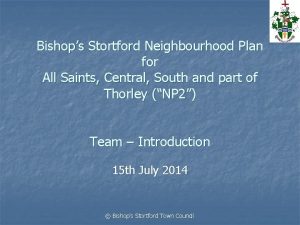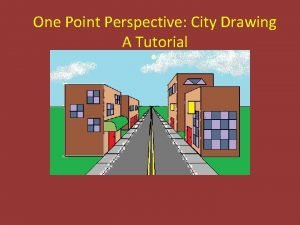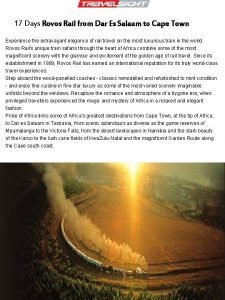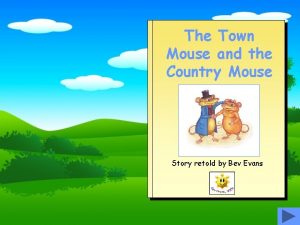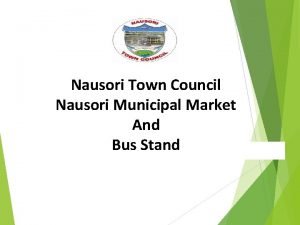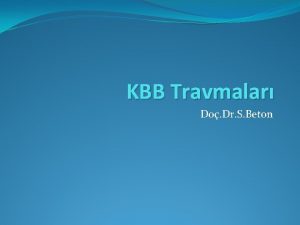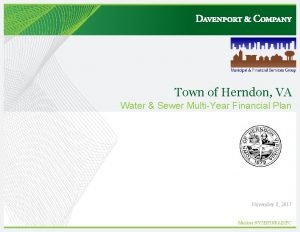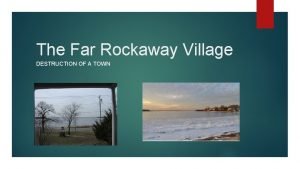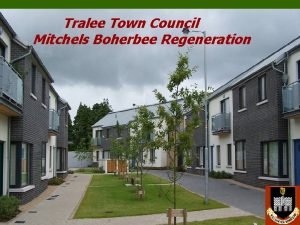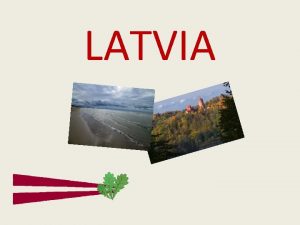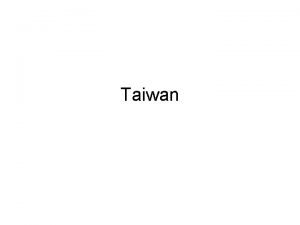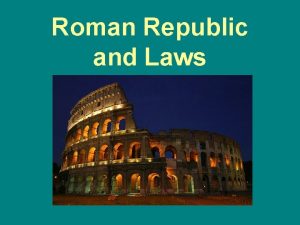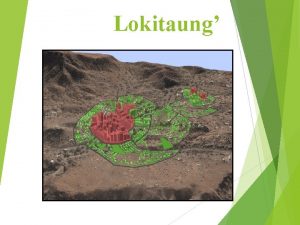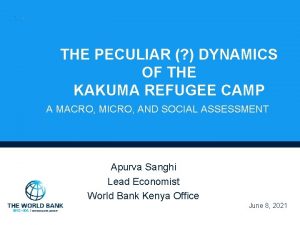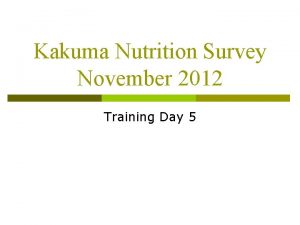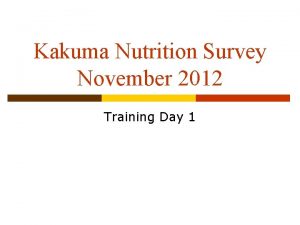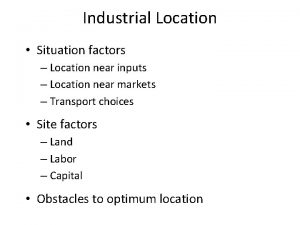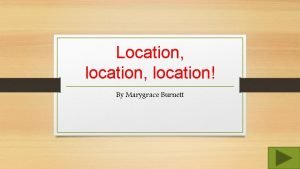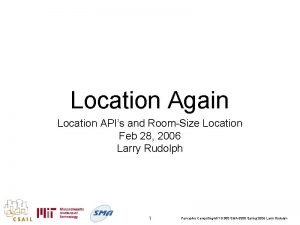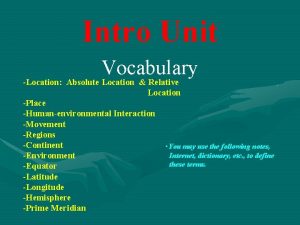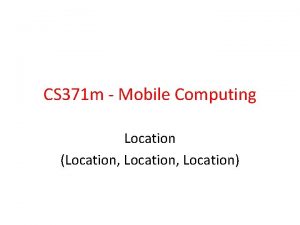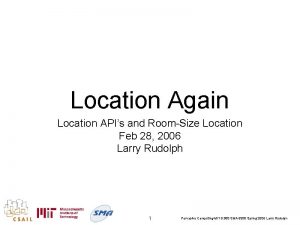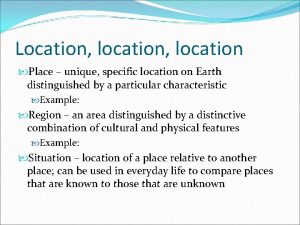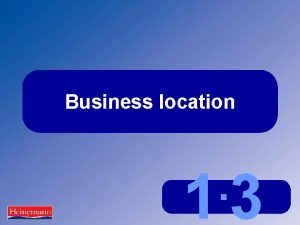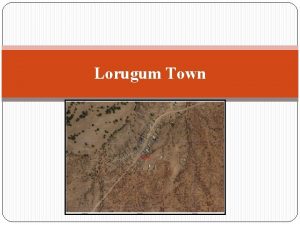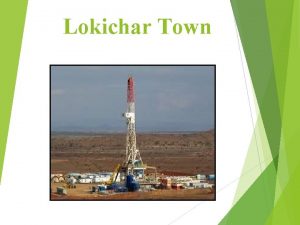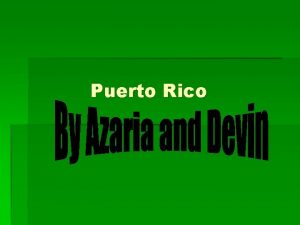Kakuma Town Location Kakuma Town is located on
















































- Slides: 48

Kakuma Town

Location Kakuma Town is located on latitude 3. 71680 N and longitude 34. 85690 E at 580 metres above sea level. The town is approximately 120 kilometres from Lodwar town and approximately 95 kilometres to Lokichoggio and 135 kilometres to Nadapal Kenya- South Sudan border point.

ISUDP VISION From the stakeholders’ consultations, the vision for Kakuma was agreed to be: “An inclusively governed commercial hub with sufficient infrastructure and sustainable resource use for prosperity for all. ”

Situational Analysis Physical characteristics & environment: A semi-arid desert with an annual mean temperature of 27. 6 °C and a total annual rainfall of 321 mm. Generally has a plain terrain with two distinct hills that is Kalemchuch. Environmental challenges Inadequate capacity of environmental management institutions, adverse climate and drought, poor SWM, invasion by Prosopis Juliflora alien species Etirae. Population characteristics: According to the 2009 population census, Kakuma town alone had a population of 31, 962. This population is expected to grow as projected below Year 2009 Population 31, 962 2015 46, 936 2025 87, 282 2035 162, 308

Existing Situation Analysis (Cont. ) • The social facilities identified were the mission hospital, Sub County hospital private clinics, 1 university, 3 secondary schools, 15 primary schools, 10 ECD centres, a social community centre, a stadium, a market, a mosque and churches. • Culture, heritage and tourism: The town has a high cultural mix caused by the influx of immigrants. There are existing eateries in the area thus the need for the establishment of hospitality facilities to cater for various classes of tourists. • SWM: no designated garbage collection points. • Waste water: According to the field survey, the primary channels of disposing “grey water” is by pouring on the roadside (34. 7%) and pouring to the drainage (28. 6%).

Existing Situation Analysis (Cont. ) Water: Kakuma town has 2 boreholes located at River Tarach and 3 shallow wells. One is located at Kakuma, another near the distribution center and two at Ong Kong near Kakuma Two. There are no treatment plants in the town and people have to treat the water individually. Energy: The major sources of energy for cooking and lighting in the area are wood and charcoal. ICT: Kakuma hosts two mobile service providers, Airtel and Safaricom. The network strength of both mobile providers is good within the town radius but is poor in the outskirts of town. Settlements: The developments in the planning area mostly comprise of huts in form of manyatta, semi-permanent and permanent structures.

Existing Situation Analysis (Cont. ) • Transport: The A 1 road passing through Kakuma town is the main road in the area, there is a single bus park that is not defined and the main public transport means are boda-bodas. There is also an existing airstrip

Existing Situation Analysis (Cont. ) Land tenure: In Kakuma, the land is predominantly under communal tenure. Housing: The predominant housing types are huts. However, new buildings are emerging mainly comprising of single rooms and flats. The bulk of the houses are semi-permanent with earth being the dominant wall material for the huts and bricks for the buildings in the urban center. Economic sector: The economic activities that are thriving in the town of Kakuma are mainly livestock trading due to demand for meat from the refugee community, provisions shops and hotels.

Existing Situation Analysis (Cont. ) Land uses: (57%) of the planning area is undeveloped while residential development account for 11% of the land use. The commercial zone has developed along the major road

Issues Identified by Stakeholders • • • Poor stakeholder involvement in development matters Poor planning Insufficient funds for development projects Insecurity within and across the border Insufficient water Illiteracy. Persistent drought Existing airstrip Poor road network/poor communication Inadequate health facilities Lack of public facilities such as fire stations, slaughter houses, security facilities, libraries, rehabilitation centres, recreation centres and public spaces

Proposed Interventions to Issues Identified by Stakeholders • Regularizing development • Reinforcing the Physical Planning Department structure • Introduce drought resistant crops such as yams to address issues of food security. • Establish irrigation schemes to solve the water shortage issue. • Public Awareness on ISUDP and development control issues • Evaluation of the A 1 road condition, design and construction of trunk road and periodic maintenance by KENHA Generating income from levies, taxes, business permits, user fees, fines and penalties and land rates to fund development projects. • Construct 1 dispensaries to serve the Town, 1 health centre, stadium, fire station and provision of market street lighting • Relocation of the airstrip •

SECTOR PLAN PROPOSALS

PHYSICAL PLANNING

Spatial Planning Considerations The process of creating this plan necessitated identifying spatial planning considerations which include: Major structuring elements: A 1 road and river Tarach. Land availability in the town exclusive of the laggas. Land suitability: unsuitable areas for development are laggas, riparian areas and hills. Terrain: The steep areas of the planning area present areas that are not easy for urban development. Existing land uses Security Environmental consideration: The areas for conservation include the laggas, the riverbeds and the hills. Prevalence of Prosopis Julifora “Etirae” is also a major concern. Refugees camp: These are considered to be special planning area because of their temporary nature and the spatial planning implications they have in the area.

Spatial Development Models Linear development model in Kakuma Town Densification development

Transport influenced development model – (LAPSSET corridor) Advantages of LAPSSET corridor passing through CBD Creates new opportunities for investment in the town and generation of employment. Revitalization of the economic growth of the town through enhanced access. Enhanced regional accessibility and connectivity within the region. The connection of flood areas will be covered within the LAPSSET project. Location of new facilities (oil and railway station). Disadvantages Maximum disruption of social and physical fabric. Relocation of buildings (public buildings, private buildings). High cost of relocation. Separation of the town into two. Difficulty of cross movements (traffic). High costs of creating interconnections. Disruption of the existing development pattern.

LAPSSET corridor passing outside the CBD Scenario ADVANTAGES Model focuses on regularization of land within the town. Leads to an easier way of transition from unplanned to planned development following the old built pattern. More economical and easier to implement. Minimum social economic disruption. Maintains the existing urban fabric, functionality, and image/character. Minimum disruption of existing facilities and properties. Creates new opportunities for investment and development. Alternative route to pass hence no congestion of the town centre. DISADVANTAGES Dispersed settlement is not easy to service. Development of transport expenditure outside and into the town will be expensive. Development of the town will be biased towards the LAPSSET corridor leading to a decline of the main CBD. This option requires very strong development control mechanisms to ensure its benefits are realized.

Illustration of the Two Scenarios

Hybrid Model in A section of the CBD

Structure Plan • Seven Broad Zones- • • Conservation Public Purpose Commercial Residential Special Zone- Airstrip Agriculture Industrial Development Guidelines for each Zone • Allowed Developments • for Each Zone

Detailed ISUDP

Social Sector Issues • Lack of recreational facilities within the town • Fire outbreaks • Inadequate infrastructure for markets eg. Sanitation, drainage • Lack of an abattoir • Cemetery not serviced and clearly delineated • Inadequate education facilities • Inadequate health facilities

Social Sector Development Actions Action/program Construction of a sports complex/Stadium -Construction of a fire station -Construct of buildings and amenities -Buy one fire engine Time Short term Cost 60 million Actor TCG Short term 60 million 50 million TCG Buy one fire engine Long term 60 million TCG Selected investment priorities include: Short term 100 million TCG Permanent structure (for fresh produce market) and drainage (for both) Fencing Market street lighting Provision of potable water Delineate and Construct up to standard abattoir to serve the town

Social Sector Development Actions Delineate and develop 20 acres of land for Cemetery Construct 11 ECDs to meet future demand Construct 8 ECDs to meet future demand Construct 2 more Primary schools by 2025 to meet future demand Construct 1 Dispensaries to serve the Town Construct and fairly distribute 2 Dispensaries to serve the Town Construct 1 Health centre Short term 50 million TCG Short term medium term 33 million 24 million 40 million TCG & GOK Short term 20 million TCG Medium term 40 million 35 million Construct 1 more Health centre to serve the increasing population Short term 35 million Medium term

INFRASTRUCTURE & TRANSPORT SECTOR

Proposed Road Network

Proposed Transport Network Improvement Activities (Short-term 2021) Road Name Section Length (km) Way leave Current road Condition Activities Required to achieve A 1 14 60 Good maintainable tarmac road with camber. Drainage and NMT facilities required. Evaluation of the road condition, design and construction of trunk road and periodic maintenance by KENHA. Arterial Streets 45. 4 60 Gravel and earth roads Design and construction to tarmac standards Sub Arterial Streets 24. 4 45 Gravel and earth roads Design and construction to gravel standards Collector Streets 44. 3 30 Gravel and earth roads Opened to gravel and earth standards Livestock Corridor 23. 2 20 Gravel and earth roads Opened to gravel and earth standards Local Streets 55. 3 15 Gravel and earth roads Opened to gravel and earth standards

Proposed Transport Network Improvement Activities (Medium-term 2025) Road Name Section Length (km) 14 Way leave Expected condition at the end of short term Activities Required to achieve 60 Evaluation of the road condition, design and construction of trunk road and periodic maintenance by KENHA Arterial Streets 45. 4 60 Sub Arterial Streets Collector Streets 24. 4 45 Good maintainable tarmac road with camber. Drainage and NMT facilities required. Good maintainable tarmac road with camber. Drainage and NMT facilities in place Gravel and earth roads 44. 3 30 Gravel and earth roads Opened to gravel and earth standards Livestock Corridor Local Streets 23. 2 20 Gravel and earth roads Opened to gravel and earth standards 55. 3 15 Gravel and earth roads Opened to gravel and earth standards A 1 Evaluation of the road condition, design and routine and periodic maintenance Design and construction to gravel standards

Proposed Transport Network Improvement Activities (Long-term 2035) Road Name Arterial Streets 45. 4 Sub Arterial Streets 24. 4 Collector Streets Livestock Corridor 44. 3 Way Expected condition at leave the end of medium term 60 Good maintainable tarmac road with camber. Drainage and NMT facilities in place 30 Gravel and earth roads 23. 2 20 Gravel and earth roads Local Streets 55. 3 15 Gravel and earth roads A 1 Section Length (km) 14 Activities Required to achieve the projected standard Evaluation of the road condition, design and routine and periodic maintenance by KENHA Evaluation of the road condition, design and routine and periodic maintenance Design and construction to tarmac standards Opened to gravel and earth standards with adequately spaced watering points and cattle dips. Design and construction to tarmac standards

Infrastructure Water Proposals • Drilling more boreholes to meet the water demands of the residents. • Consideration of introduction of sand dams across the laggas to supplement the borehole water sources • Construction of water storage tanks to regulate the water supply from the boreholes Sanitation Proposal Construction of a sewer system and a sewage treatment plant that has the capability to recycle waste water Electricity Supply Proposals Completion of the construction of the sub-station in the town. This would ensure adequate supply of electricity for the town for decades even at the current population growth rate. Investing in renewable energy such as wind power and solar energy to supply electricity to the town. Increasing the number of generators in the town. However this is only a temporary solution since power produced by generators is limited, expensive and unreliable. Solar farms seem like a favorable option although the capital expenditure would be high.

Telecommunications Proposals • Offering subsidized rates to mobile service providers by the County Government • Promotion of affordable mobile phones to residents to increase purchase Solid Waste Management Proposals Designation of a proper garbage disposal system, with designated temporal transfer hubs, before terminating in Lochelel dumping site. Community awareness and sensitization as well as community involvement in maintaining proper sanitation standards. Towards this end, incentives should be given to the community members involved. Regular and continuous maintenance of the implemented sanitation measures.

Proposed Infrastructure Plan

Transport & Infrastructure CIP Sector Project TRANSPORTATION Roads Kakuma A 1 Road (14 Km) Estimated Time-Frame Cost (Kshs) Implementers Remarks 1. 4 billion (100 million/Km) Ke. NHA The road requires reconstruction TCG & KURA The road requires construction Short Term Arterial Streets (45. 4 Km) 2. 8 billion (60 million/Km) Sub-Arterial Streets (24. 4 Km) 1. 3 billion (50 million/Km) Medium Term TCG & KURA Collector Streets (44. 3 Km) 2 billion (45 million/Km) Long Term TCG & KURA Local Streets (55. 3 Km) (40 million/Km) Bridge 1 (200 m) 100 million 500, 000/m Short Term Bridge 2 (400 m) 200 million 500, 000/m Medium Term Along collector 5 Bridge 3 (400 m) 200 million 500, 000/m Long Term Along collector 10 Bridge 4 (100 m) 100 million 500, 000/m Long Term Along sub-arterial 7 Terminals Bus-station (4000 sqm) 60 million Short Term Parking 2 -Truckparks 10 acres each 100 million Bridges TCG & KURA Along the A 1 Requires terminal facilities & drainage.

Transport & Infrastructure CIP Sector Project Estimated Cost (Kshs) 5 billion Time-Frame Implementers Remarks Airport Kakuma Airport Medium Term & Long Term TCG & KAA Phase I: Relocate and upgrade to functioning airstrip. Phase II: Upgrade to Airport. 25 million (@Ksh. 5 m) Short Term TCG & WARMA 100 million (@Ksh. 10 m) Medium Term TCG & Relevant Sewerage & Water Co. Construction of a dam on the Tarach River Provision of storage water 20 No. ( 50 m 3 each) 5 billion Long Term 200 million Short Term Provision of safe potable water 500 million Medium Term Centralized Sewerage Treatment System 500 million 32, 000 m 3/ day Medium Term Along R. Tarach Low-rate, anaerobic treatment. INFRASTRUCTURE Water Supply Additional boreholes (5 No. ) & water reticulation New sand dams (10 No. ) & pumping/equipm ent &reticulation Water Tanks Water Treatment Plants Sanitation Energy Dumpsite Solar Farms 80 MW 25 million Short Term 24 billion Long Term Ksh. 1. 2 billion/4 MW TCG & REA & KENGEN (4 MW/ 15 acres)

Environment Sector

Environmental problem map

Environmental Strategies

ISSUE CHALLENG E Inadequate environment resources al management institution AREA STRATEGY Town Mobilize wide. resources for environmental and natural resource management programmes Poor management of Solid waste Lack of Built Establish and gazetted and up gazette a designated areas. dumpsites and inadequate environmenta l awareness among the community members. Loss of vegetation cover Informal urbanization PROGRAM/ACTI TIME COST ACTORS ON Development and Short Ksh TCG, Govt. establishment of term. 100 m (NEMA, environmental and KFS, natural resources KEFRI, department. CBOs, NGOs). COMPLIANCE INDICATORS Environmental and natural resource management, personnel, legal framework, infrastructure and empowerment of stakeholder Provide waste Short Ksh. TCG, Gazetted dumpsite. storage, collection term. 100 m Residents, SWM equipments. & transportation Long NEMA, facilities. Recycle, c term NGOs, ommunity training CBOs and registration of registered group. Safe disposal. Town Formulation of Development of wide policies and urban forestry bills that programmes govern natural resources management e. g. urban Long term Ksh TCG, KFS, Landscaping, road 100 m Residents side tree planting, NEMA. botanical gardens, recreational gardens, riparian protection and tree planting

ISSUE CHALLENG ARE STRATEGY E A PROGRAM/ACT TIME COS ACTORS COMPLIANCE ION T INDICATORS Prosopis Juliflora (Etirae) Very fast Town Prosopis Management of Long Ksh KFS, growth/ wide management invasive species. term 100 m KEFRI, colonization policy and bill. NEMA, & thorns Value chain TCG, analysis for CBOs, Prosopis NGOs, product. Residents Exploitation and utilization Policy and bill. Utilisation of the plant & its products. Acreage cleared reclaimed, and restored. Flooding Degraded catchment areas Catc Mapping of hmen degraded t areas in town Construction of water harvesting structures, storm drainage systems and catchment areas protection. Poverty induced environment al degradation. Low inco me areas in the town Allocate resources and rehabilitate degraded areas Long Ksh TCG, term 300 m Central Govt. , Alternative Research on Long Ksh. livelihoods utilization of non- term 50 m and promote wood products nature based enterprises TCG, CDF Diversified economic youth & activities womenfun d. SMEs, C BOs, NGOs, Govt arms

ISSUE CHALLENG E AREA STRATEGY PROGRAM/ACTI TIME COST ACTORS ON COMPLIANCE INDICATORS Environment Low Town Enhance al awareness. residents’ wide. environmental environmenta consciousness l awareness. among town resident. Use electronic and print media, posters, public meetings, organized sector forums and groups. More environmental consciousness & ethics among town residents. Environment al Management tools. Low Town Ensure/promot application of wide e application of EIAs, EAs, environmental SEAs& other management environmenta tools l management tools. Create more Short Ksh. awareness on the term. 2 m tools. Monitors & enforce their application where necessary. Drought toll on Human & livestock Enhance capacity Long in drought term forecasting, early warning systems, mitigation & adaptations. Town Establish wide weather stations Long term. Ksh. 12 m TCG, NEMA, Environme ntal Sectoral actors. NEMA, Number of EIAs, TCG, SEAs, EA reports. Environme ntal sectoral players Ksh. DMA, 100 m TCG, Dpt. of Met. , Min. of specialpro grams, MENR, Min. of agric& Livestock Established weather stations. Drought management institution. Technical reports. Reduced drought toll.

Economic Sector

Refugees The presence of the refugees in Kakuma has resulted to a vigorous economy through the creation of trade opportunities, interaction between the host and refugee communities, improved social amenities and job opportunities. The economy of Kakuma town can be said to be heavily supported by the refugee activities in the camps Measures to ensure economy continues to thrive even if the refugee population were to reduce: Balanced infrastructure provision for both the refugees and host communities Employment creation and diversification of economic activities. Structured marketing for local goods.

Economic Development Strategies Pastoralism Establish social amenities such as boarding schools and clinics to support the pastoral communities. Provision of veterinary services. Livestock holding ground. Access to credit facilities by the pastoral communities to be established and existing ones improved. Opportunities for value addition such as meat processing, hides and skins processing, handcrafts be established. Finding markets for animal products outside the town. Tourism Development Improve the status of the historical heritage sites and monuments to become more appealing to tourists. Building facilities such as roads leading to the heritage sites and monuments to support their development as tourist attraction sites. Engage locals in the development of the heritage sites to increase local tourism in the identified sites. Market Kakuma as a tourist destination by highlighting the aforementioned attraction sites in marketing activities. Developing tourist lodges and leisure facilities to support tourism development. Developing cultural based artifacts to enhance cultural tourism to generate revenue to locals.

Transport Sector Agriculture Maintenance of the roads and Introduce other new drought resistant improvement of the drainage facilities crops such as yams to address issues of food security. Link roads require to be tarmacked. The expansion of the A 1 road in collaboration with KENHA Upgrading the link roads between rural areas and the town to increase accessibility, thus promoting growth. Establish irrigation schemes. . Educate the farmers on effective pest and weed control methods. Provide farmers with farm inputs such as pesticides and fertilizers. Build bridges across laggas to enhance Collaboration with stakeholders such as the connectivity between the town and the World Food Program to establish rural areas. best farming methods in the town.

Small and Medium Enterprises (SMEs) Development Proposals for Income Generation for TCG Decentralization of the issuance of business permits/licences from Lodwar to Kakuma to lower the cost of establishing businesses. Issuance of single business permits. Beefing up security in the town to enhance investor confidence. Construction of access roads from the main roads to enhance accessibility to business enterprises. Ensuring there is enough serviced land for business needs by clearing needs and availing land for business establishments. Increasing access to finance by providing credit facilities to SMEs with inadequate or no collateral. Earmarking suitable sites that can be disposed to investors for development of recreation facilities foreign tourists and local residents. Levies and Taxes Licenses and Business Permits User Fees Revenues from doing business Fines and penalties Land rates

SUMMARY OF CAPITAL INVESTMENT PLAN

Summary of Estimated Total Costs per Sector i. Transport & Infrastructure sector Short term: KES 4. 2 billion Medium term: KES 7. 3 billion Long term: KES 31 billion Overall total 42. 5 billion ii. Social sector Short term: KES 408 million Medium term: KES 139 million Long term: KES 60 million Overall total 607 million iii. Environmental sector The investment for environmental infrastructure which is 794 million will be able to cover the town for the whole planning period Grand Total (i, ii and iii) 43. 901 Billion

Conclusion The above proposals are transformative and innovative for the development of Kakuma Town in the plan period and can be actualized through: • Political good will • Rational allocation of resources • Stakeholder involvement • Capacity building on county personnel & institutions
 Town b is 380 km due south of town a
Town b is 380 km due south of town a Contoh freestanding location
Contoh freestanding location Chapter 8 location planning and analysis
Chapter 8 location planning and analysis A cross country skier moves from location a
A cross country skier moves from location a As the doctor approaches, why is kino feeling rage?
As the doctor approaches, why is kino feeling rage? Sponge susie
Sponge susie Once upon a time mouse
Once upon a time mouse Peabody town hall
Peabody town hall Falmouth town council
Falmouth town council Waverly town hall
Waverly town hall Town of salem
Town of salem Fill in the gaps with the right prepositions
Fill in the gaps with the right prepositions Monkey river town belize hotels
Monkey river town belize hotels Cadillac d'al capone
Cadillac d'al capone Ae housman to an athlete dying young
Ae housman to an athlete dying young St ives town council cornwall
St ives town council cornwall He was born in 1452 in the small town of vinci
He was born in 1452 in the small town of vinci Transition town definition
Transition town definition Nhlangano town council
Nhlangano town council Town of wrightsville beach public works
Town of wrightsville beach public works Kentish town doctors
Kentish town doctors Amadur rahman
Amadur rahman Tracey david swena
Tracey david swena Evesham town plan
Evesham town plan Chapin town hall
Chapin town hall Henley town hall
Henley town hall Old town properties fernandina
Old town properties fernandina Cleethorpes town centre
Cleethorpes town centre Colfax town hall
Colfax town hall Urmston town centre
Urmston town centre Earth chakras and ley lines
Earth chakras and ley lines Repetition sound device
Repetition sound device Southside locos
Southside locos Ja business town
Ja business town Lisa chandler suffolk
Lisa chandler suffolk Zanzibar stone town heritage society
Zanzibar stone town heritage society The rodriguez brothers circus
The rodriguez brothers circus Bishops stortford town council
Bishops stortford town council City perspective drawing tutorial
City perspective drawing tutorial There isn't a bank in our town
There isn't a bank in our town Rovos rail cape town to dar es salaam
Rovos rail cape town to dar es salaam What was the noise that the country mouse heard
What was the noise that the country mouse heard Nausori town council
Nausori town council Telekantus
Telekantus Nh town clerk association
Nh town clerk association Town of herndon water
Town of herndon water East rockaway town hall
East rockaway town hall If you're in the tiny spanish town of bunol
If you're in the tiny spanish town of bunol Tralee town council
Tralee town council

